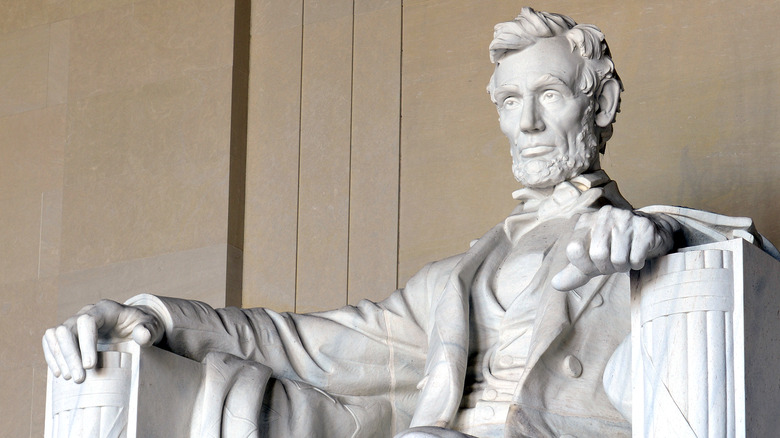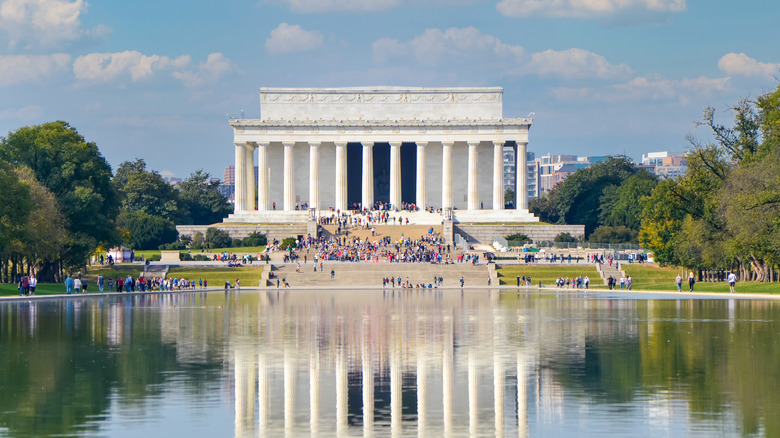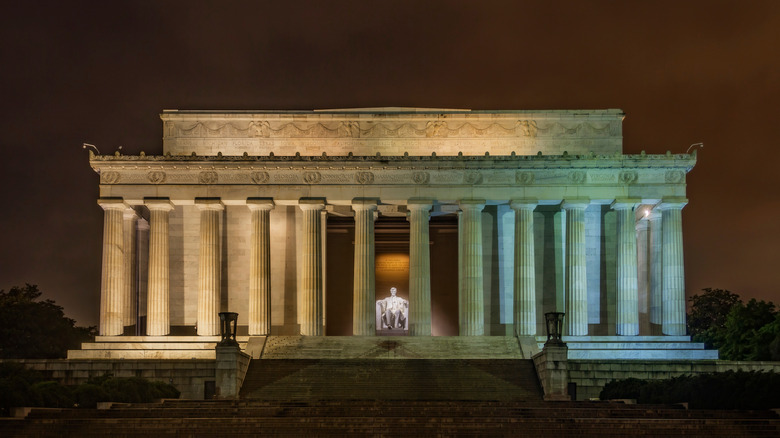Is There Really A Typo In The Lincoln Memorial?
The Lincoln Monument Association was incorporated in 1867, just two years after 16th president of the United States Abraham Lincoln was assassinated while sitting in the audience at Ford's Theatre in Washington, D.C. Per the National Park Service, ground was first broken for the memorial's foundation on February 12, 1914. The cornerstone was laid a year later and builders completed the foundation in May of 1915.
The exterior was designed by New York architect Henry Bacon, who modeled the structure after Greece's iconic Parthenon building. Bacon directed the builders to use stone from several different states, including Massachusetts granite, Colorado and Alabama marble, Tennessee pink marble, and Indiana limestone. The statue of Lincoln (shown above), is made of up of 28 pieces, stands 19 feet tall and 19 feet wide, and weighs a total of 120 tons (175 including its pedestal) per the National Park Service. It was designed by Massachusetts sculptor Daniel Chester French, who studied photographs and descriptions of Lincoln during the Civil War as well as 1860 castings of Lincoln's hands to create the final result. The hands were of particular importance to French. Per History, he wrote "It has always seemed to me that the hands in portraiture were only secondary to the face in expression, and I depend quite as much upon them in showing character in force."
The Lincoln Memorial took a lot of time and money to complete
According to the National Park System, the murals that decorate the interior of the Lincoln Memorial were painted by Missouri artist Jules Guerin. The two canvas paintings measured 60 feet long by 12 feet high and weighed 600 pounds. The first watercolor, "Emancipation," hangs above a carving of the Gettysburg Address and showcases the Angel of Truth emancipating enslaved people from shackles. The second painting, "Unity," hangs above Lincoln's Second Inaugural Address and features the Angel of Truth linking two hands, each of which resembles the northern United States and the southern United States. The paintings symbolize one of Lincoln's primary achievements from his presidency: signing the Emancipation Proclamation that stated, per the National Archives "that all persons held as slaves...are, and henceforward shall be free."
As reported by the National Park Service, the dedication of the Lincoln Memorial took place on May 30, 1922 with a total cost of $3,045,400. Per Boundary Stones, the history website of PBS station WETA, thousands of people attended the dedication ceremony, including Civil War soldiers from both the North and South. Also present was Abraham Lincoln's son Robert Todd Lincoln, then 79 years old, who made his last public appearance at the ceremony.
Despite the celebration of Lincoln's achievements in emancipation and unity, seating at the ceremony was strictly segregated, as was the law and custom in Washington, D.C. in the 1920s. The one Black speaker, Robert Russa Moton, had an original speech deemed too radical by the Lincoln Memorial Commission, forcing him to read a milder version.
Looking closely at the Lincoln Memorial's engravings
Despite all the hard work and care that went into the construction of the Lincoln Memorial, there was one mistake made during the engraving on the walls of the monument. The Second Inaugural Address, per the National Park Service, reads in part "The progress of our arms, upon which all else chiefly depends is as well known to the public as to myself and it is I trust reasonably satisfactory and encouraging to all. With high hope for the future no prediction in regard to it is ventured." Lincoln read the speech just 41 days before he was assassinated, and within it discussed his plans to heal and reunite the United States after the divisions of the Civil War.
As reported by Ripley's, one of the engravers made a typo while carving the word "future" in the second line of the address, chiseling an "E" instead of an "F." The mistake was caught and the bottom line was filled in to create the necessary "F". However, the mistake is still visible to anyone who looks closely, reminding the public that all monuments, regardless of their size and importance, are susceptible to human error.


